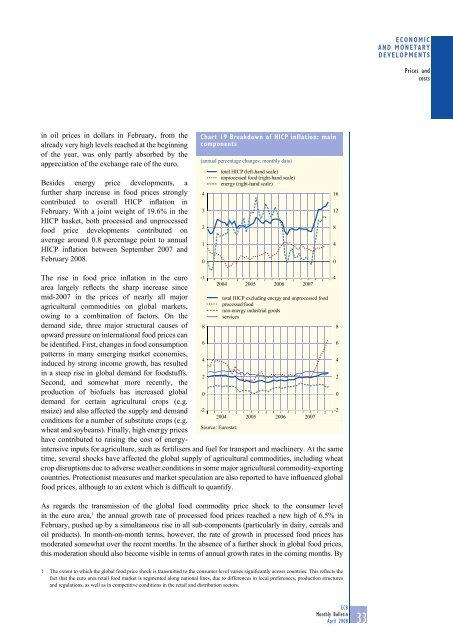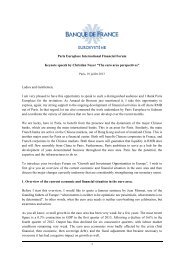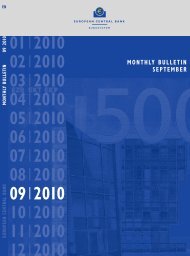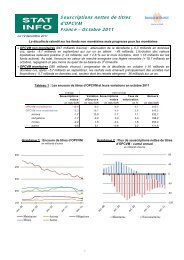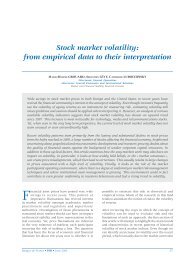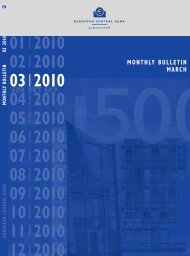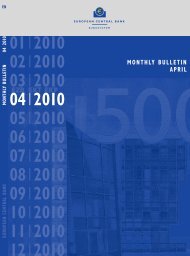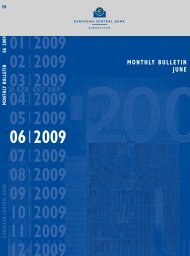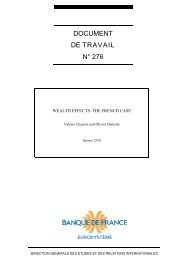Monthly Bulletin April 2008 - European Central Bank - Europa
Monthly Bulletin April 2008 - European Central Bank - Europa
Monthly Bulletin April 2008 - European Central Bank - Europa
You also want an ePaper? Increase the reach of your titles
YUMPU automatically turns print PDFs into web optimized ePapers that Google loves.
ECONOMIC<br />
AND MONETARY<br />
DEVELOPMENTS<br />
Prices and<br />
costs<br />
in oil prices in dollars in February, from the<br />
already very high levels reached at the beginning<br />
of the year, was only partly absorbed by the<br />
appreciation of the exchange rate of the euro.<br />
Besides energy price developments, a<br />
further sharp increase in food prices strongly<br />
contributed to overall HICP inflation in<br />
February. With a joint weight of 19.6% in the<br />
HICP basket, both processed and unprocessed<br />
food price developments contributed on<br />
average around 0.8 percentage point to annual<br />
HICP inflation between September 2007 and<br />
February <strong>2008</strong>.<br />
Chart 19 Breakdown of HICP inflation: main<br />
components<br />
(annual percentage changes; monthly data)<br />
4<br />
3<br />
2<br />
1<br />
0<br />
total HICP (left-hand scale)<br />
unprocessed food (right-hand scale)<br />
energy (right-hand scale)<br />
16<br />
12<br />
8<br />
4<br />
0<br />
The rise in food price inflation in the euro<br />
area largely reflects the sharp increase since<br />
mid-2007 in the prices of nearly all major<br />
agricultural commodities on global markets,<br />
owing to a combination of factors. On the<br />
demand side, three major structural causes of<br />
upward pressure on international food prices can<br />
be identified. First, changes in food consumption<br />
patterns in many emerging market economies,<br />
induced by strong income growth, has resulted<br />
in a steep rise in global demand for foodstuffs.<br />
Second, and somewhat more recently, the<br />
production of biofuels has increased global<br />
demand for certain agricultural crops (e.g.<br />
maize) and also affected the supply and demand<br />
conditions for a number of substitute crops (e.g.<br />
wheat and soybeans). Finally, high energy prices<br />
have contributed to raising the cost of energyintensive<br />
inputs for agriculture, such as fertilisers and fuel for transport and machinery. At the same<br />
time, several shocks have affected the global supply of agricultural commodities, including wheat<br />
crop disruptions due to adverse weather conditions in some major agricultural commodity-exporting<br />
countries. Protectionist measures and market speculation are also reported to have influenced global<br />
food prices, although to an extent which is difficult to quantify.<br />
As regards the transmission of the global food commodity price shock to the consumer level<br />
in the euro area, 1 the annual growth rate of processed food prices reached a new high of 6.5% in<br />
February, pushed up by a simultaneous rise in all sub-components (particularly in dairy, cereals and<br />
oil products). In month-on-month terms, however, the rate of growth in processed food prices has<br />
moderated somewhat over the recent months. In the absence of a further shock in global food prices,<br />
this moderation should also become visible in terms of annual growth rates in the coming months. By<br />
-1<br />
8<br />
6<br />
4<br />
2<br />
0<br />
-2<br />
2004 2005 2006<br />
2007<br />
total HICP excluding energy and unprocessed food<br />
processed food<br />
non-energy industrial goods<br />
services<br />
2004 2005 2006<br />
Source: Eurostat.<br />
2007<br />
-4<br />
8<br />
6<br />
4<br />
2<br />
0<br />
-2<br />
1 The extent to which the global food price shock is transmitted to the consumer level varies significantly across countries. This reflects the<br />
fact that the euro area retail food market is segmented along national lines, due to differences in local preferences, production structures<br />
and regulations, as well as in competitive conditions in the retail and distribution sectors.<br />
ECB<br />
<strong>Monthly</strong> <strong>Bulletin</strong><br />
<strong>April</strong> <strong>2008</strong><br />
33


